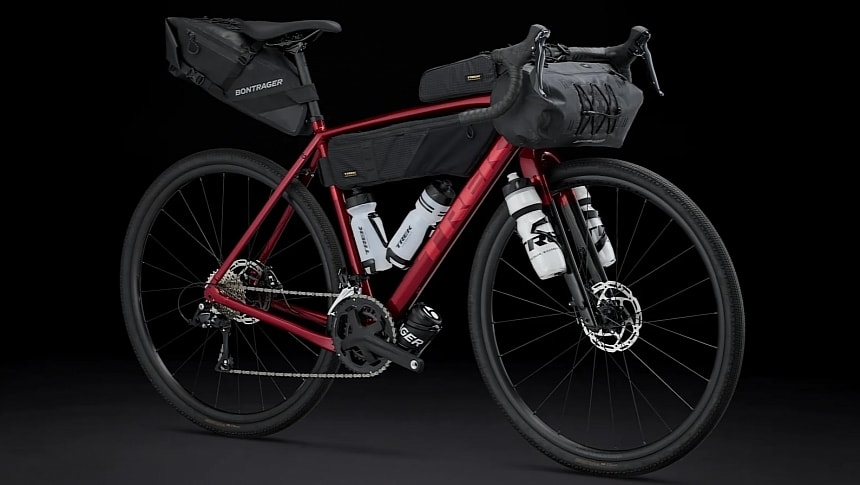With the wave of gravel biking that's been sweeping across the globe in recent years, we've reached a stage where you can get your hands on a rather affordable and capable machine. Take the new Checkpoint ALR 3 from Trek as the perfect example of what I mean.
Folks, the rather flashy two-wheeler before you today is none other than Trek's Checkpoint ALR 3, this brand's budget-friendly solution to getting you into the gravel game today. How "budget?" Well, how about an MSRP of no more than $1,300 for what we see? Sounds like a sweet deal, so let's see what's in store.
First and foremost, let's analyze the backbone for this ride: none other than the frame. Here, Trek was able to keep the price down on the ALR 3 to a minimum in comparison to its carbon fiber brethren, and the way they achieved this was by going for that good old industry-trusted aluminum. In this case, 300 series Alpha Aluminum is used, Trek's proprietary alloy blend, ensuring they can integrate their latest gravel-riding tech into the least expensive mold possible.
That frame is then loaded with all the features a modern gravel rider would love to have and even seek. For example, internal cable routing ensures you don't snag your lines on anything and gives this hunk of aluminum a nice, clean look, but if we look closely, we can see cargo mount after cargo mount all over the frame and fork. The seat stays have them, and so do the seat tubes, but the down tube is absolutely covered in this adventure-unlocking feature. Even the top tube and fork all have mounts everywhere.
For a moment, try and picture what an ALR 3 frame would look like if you added panniers to the rear, a triangle bag hanging from the top tube and another on top, a water bottle cage chilling on the seat tube, and we haven't even started to include the down tube, fork, or handlebar bags in this vision. Go ahead and load it up, but not past 275 lbs with the rider, cargo, and bike combined.
The last feature that makes up the ALR 3's backbone is the fork. What I liked about this feature is that Trek decided to throw in a bit of carbon fiber for this price. That's right, a full carbon fork is mounted to the front of the ALR 3, and this feature will reduce some of the vibrations that the road will throw at you.
Speaking of vibrations and road chatter, one key component of gravel bikes is the tire size, and for this bike, the manufacturer aimed to make this ride as comfortable as possible without feeling cumbersome or bogged down. As such, you can rock tires with up to a 45 mm cross-section, but as standard, a pair of Bontrager Girona Pros with 42 mm sizing are in place. Those are sitting on a pair of tubeless-ready Paradigm rims, also from Bontrager.
Now, as we move deeper into the magic the ALR 3 has to offer, we arrive at the all-essential drivetrain. Here, Trek has chosen the Sora system from Shimano in order to give us a more budget two-wheeler. Yet, this setup also yields a 2x9 gear range, so you're sure to be able to find that sweet spot for your cadence. Overall, the Sora HG400 cassette offers an 11-32T range, and the crankset is completed by an FSA Omega with 46 and 30T. One important thing to consider is that the Sora rear derailleur can handle up to 34T rings. Brakes, on the other hand, are a pair of Tektro mechanical disc brakes clamping down on 160 mm rotors.
Beyond this, Bontrager is to thank for most of the secondary components, such as the stem, which is Blendr compatible, the handlebar, the seat post, and even the tire sealant. The neat thing is that when it's all said and done, the ALR 3 weighs no more than 23.3 lbs (10.6 kg) for a size M frame. That's one hell of a light bike for this sort of price.
The question is whether or not this one's for you. Well, there are a couple of ways you can go about things. The first is to grab one directly from Trek and try it out under their 30-day warranty. But, if you don't want to dish out the cash first, plenty of Trek dealerships will let you take one out for a spin before dropping your hard-earned cash on it. If you're in the market for a budget gravel bike, the ALR 3 may just be the one for you.
Finally, picture yourself grabbing one of these babies and come Saturday morning, you and your riding buddies get ready to take a two-day trek to the edge of town and back. With the Checkpoint ALR 3 sitting in the garage, loaded up with all the frame bags I mentioned, you hop on, secure your helmet, clip in, and ride off. Enjoy the rides.
First and foremost, let's analyze the backbone for this ride: none other than the frame. Here, Trek was able to keep the price down on the ALR 3 to a minimum in comparison to its carbon fiber brethren, and the way they achieved this was by going for that good old industry-trusted aluminum. In this case, 300 series Alpha Aluminum is used, Trek's proprietary alloy blend, ensuring they can integrate their latest gravel-riding tech into the least expensive mold possible.
For a moment, try and picture what an ALR 3 frame would look like if you added panniers to the rear, a triangle bag hanging from the top tube and another on top, a water bottle cage chilling on the seat tube, and we haven't even started to include the down tube, fork, or handlebar bags in this vision. Go ahead and load it up, but not past 275 lbs with the rider, cargo, and bike combined.
The last feature that makes up the ALR 3's backbone is the fork. What I liked about this feature is that Trek decided to throw in a bit of carbon fiber for this price. That's right, a full carbon fork is mounted to the front of the ALR 3, and this feature will reduce some of the vibrations that the road will throw at you.
Now, as we move deeper into the magic the ALR 3 has to offer, we arrive at the all-essential drivetrain. Here, Trek has chosen the Sora system from Shimano in order to give us a more budget two-wheeler. Yet, this setup also yields a 2x9 gear range, so you're sure to be able to find that sweet spot for your cadence. Overall, the Sora HG400 cassette offers an 11-32T range, and the crankset is completed by an FSA Omega with 46 and 30T. One important thing to consider is that the Sora rear derailleur can handle up to 34T rings. Brakes, on the other hand, are a pair of Tektro mechanical disc brakes clamping down on 160 mm rotors.
The question is whether or not this one's for you. Well, there are a couple of ways you can go about things. The first is to grab one directly from Trek and try it out under their 30-day warranty. But, if you don't want to dish out the cash first, plenty of Trek dealerships will let you take one out for a spin before dropping your hard-earned cash on it. If you're in the market for a budget gravel bike, the ALR 3 may just be the one for you.
Finally, picture yourself grabbing one of these babies and come Saturday morning, you and your riding buddies get ready to take a two-day trek to the edge of town and back. With the Checkpoint ALR 3 sitting in the garage, loaded up with all the frame bags I mentioned, you hop on, secure your helmet, clip in, and ride off. Enjoy the rides.











